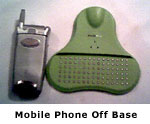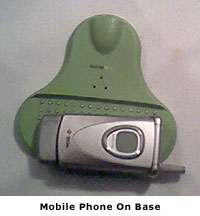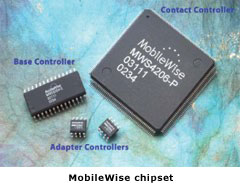WIRELESS RECHARGING
SANTHOSH KUMAR V
ENROLL 159/05
B-TECH FOURTH YEAR,
ELECTRONICS AND COMMUNICATION
NATIONAL INSTITUTE OF TECHNOLOGY,
SRINAGAR
WIRELESS RECHARGING
ABSTRACT
“NECESSITY IS THE MOTHER OF INVENTIONS”…
A problem that's hindering the freedom and productivity of true mobility in our lives is our need to carry and use bulky chargers, power adapters and cords for all the mobile electronic devices we use, such as cell phones, laptop computers, portable music players and many others. What if there were a single charging solution that would make all these chargers and adapters redundant, that could charge all our devices simultaneously, and would be as simple as placing a mobile device down on a desk!!
This necessity has led to the innovative invention of a ”WIRELESS RECHARGING SYSTEM”
Instead of each device needing its own charger, it is possible to recharge phones and cameras by placing them on a plastic pad the size of a mouse mat. A dense array of coils buried in the pad will transmit energy to the gadget to charge its batteries. And it will be possible to charge as many gadgets as can fit on the pad at once.
This next-generation solution wirelessly charges any device - ranging from PDAs and mobile phones to personal music players, imaging devices etc and is dedicated to revolutionizing electric power delivery to mobile devices through safe, sleek, wire-free means.
1.INTRODUCTION
The tangle of cables and plugs needed to recharge today's electronic gadgets could soon be a thing of the past. No messy wires, no tangled cord, no multiple plugs!
Imagine a world where all your portable devices can be charged and powered simply by placing them on a flat pad. New wireless technology lets people recharge notebooks, cell phones and other devices by setting them on a pad instead of plugging them in or dealing with a docking station.
This next generation solution is based around technology that uses inductive coupling as a means of power transfer - which means you don't need any wires, connectors or contacts between the pad and the device. The pads use electromagnetic induction to charge devices.
2.COMPONENTS
The wireless recharging solution has two parts:
2.1.Receiver Module
A sub-millimeter thin module that can be customized to about any size, shape or curve of a device is fixed inside the device and makes no visible impact to product appearance. Designed for use in PDAs, mobile phones, personal music players and portable gaming devices, as well as a host of other consumer electronic products, it enables immediate, safe and contact less recharging for the first implementation of a truly wireless mobile lifestyle.
2.2.Recharging Pad
This Pad is a thin (less than 6mm) universal wireless charging platform that plugs into any electrical outlet and can be built into any surface with no possibility of shock or discharge.
The base can deliver over 240W, is safe from spills and does not emit radiation or cause radio interference.
The base station is plugged into an AC adapter and can deliver up to 30V DC to an individual device. It's also completely safe, and if any charge were delivered to a person, it would be at the level of a low-voltage battery, virtually imperceptible to humans and certainly not harmful. The final base units will be waterproof and protected from electrostatic charges.
Any device fitted with the module instantly begins to recharge when placed anywhere on the Pad in a safe and totally contact less fashion and multiple devices can be charged simultaneously on a single pad.
This pad conforms to worldwide safety standards and regulations.


3.WORKING
The components work with the help of a chipset. The chipset basically has 2 kinds of chips and enables "Wire-Free" electric power transfer.
One chip, the tiny Adapter Controller, goes inside the mobile device and the other, the Contact Controller, gets built into the power base station.
These power bases, which come in a wide variety of shapes, sizes and colors, are each covered in an array of gold-plated contacts. The retrofitted mobile devices also have a pair of contacts.
The adapter chip inside the handheld device will, when placed on a base station, receive a very small electrical signal and message from the base controller chip that will power up the adapter chip. The base controller chip will sense for polarity. If there is none (say you place your hand on the base) then it does nothing. If it does find polarity and a signal from the adapter chip, it will then read information about the voltage level necessary to run the mobile device and begin charging and powering it.
Because of the array of contacts—from dozens to hundreds, depending on base size—there's no need to place the device in a special spot or position on the base. In fact, the bases accept multiple devices, charging and powering them all at once. Thus, there is no need for alignment of receiving module and charging base.
4.BASIC PRINCIPLE
Researchers have known that wires don't always need to be in contact for electric power to get transferred.
This wireless recharging technology can work on two principles:
i.resonance ii.electro magnetic induction
4.1.Resonance
It is a phenomenon that causes an object to vibrate when energy of a certain frequency is applied.
When you have two resonant objects of the same frequency, they tend to couple very strongly.
Resonance can be seen in musical instruments. For example, when you play a tune on one, then another instrument with the same acoustic resonance will pick up that tune, it will visibly vibrate.
Instead of using acoustic vibrations, this system exploits the resonance of electromagnetic waves. Electromagnetic radiation includes radio waves, infrared and X-rays.
The technology is based on a method that uses an electromagnetic field to couple the power source to the gadget to be charged. Energy is transferred to the gadget because its antenna resonates at the same frequency as the transmitter, while other objects in the room do not absorb energy because they do not resonate at this frequency. The researchers call this process non-radiative energy transfer. In addition, the transmitter would reabsorb much of the energy that is not absorbed by the gadget.

Thus, a simple copper antenna designed to have long-lived resonance could transfer energy to a laptop or a mobile phone with its own antenna resonating at the same frequency.
Gadget and power source each employ the same resonant structure, which is an antenna for exchanging energy. The researchers investigated two types of resonant structures - a disk of dielectric material and a loop of wire bisected by capacitive plates. The simulations suggested that the loop would be a better choice under real-world conditions because less energy would be absorbed by nearby objects including humans. Calculations suggested that energy transfer efficiencies of 15% or greater could be achieved, which the researchers claim is large enough for practical applications.
working with resonance
1) Power from mains to antenna, which is made of copper
2) Antenna resonates at a frequency of 6.4MHz, emitting electromagnetic waves
3) 'Tails' of energy from antenna 'tunnel' up to 5m (16.4ft)
4) Electricity picked up by laptop's antenna, which must also be resonating at 6.4MHz. Energy used to re-charge device.
5) Energy not transferred to laptop re-absorbed by source antenna. People/other objects not affected as not resonating at 6.4MHz
4.2.Electromagnetic induction
Electric motors and power transformers contain coils that transmit energy to each other by the phenomenon of electromagnetic induction. English scientist Michael Faraday, who found out that a changing magnetic field induces a current in a nearby circuit, discovered this phenomenon.
One way to operate the system is to use electromagnetic induction to send recharging electricity to the battery. Contact less electricity delivery is made through a pad that has a coil for transmission, and a reception coil inside the rechargeable device. So, a current running in an emitting coil induces another current in the receiving coil; the two coils are in close proximity, but they do not touch. Thus, current flows through the receiving coil and charges up the rechargeable battery.
In addition to the coil there's also a regulator, which adjusts the amount of power being supplied to the device so the battery charges correctly. By fitting the regulator into each device, a number of gadgets with different power requirements can be charged simultaneously.
Electromagnetic induction is a technology that is currently employed in a wide range of applications. Applications, which currently use induction for power transfer, include powering electric vehicles, recharging electric toothbrushes and powering smart-tags.
5.FEATURES
This technology has developed a new way of powering devices based on wireless power:
5.1.Features of the system
It eliminates the need for a different charger for every gadget.
You can charge more than one device at a time
The whole process becomes easy and hassle-free
No need for alignment of receiving module and charging base
Thin, flexible, customizable power receiver.
5.2.Features of the pad
Generates inductive field to power any module-enabled device placed on the pad.
Uniform performance across charging surface.
the system is perfectly safe and will not even wipe credit cards if you accidentally put one on the pad.
Sizes can vary from one-device to many-devices
Stand-alone and integrated versions demonstrated
Generally, the pad is provided with a cord to be connected to the ac mains if there is a possibility. Else, it can be alternatively operated with the help 12 V batteries.
Such a version is called a stand-alone or an integrated version, as it is capable to handle the recharging operation even without an external power supply and is provided with the option of using batteries instead. In this case, the technology becomes completely wireless where power from ac mains is not required.
It gives us freedom to charge our cell phones, MP3 players, PDAs or any other such hand held devices whenever and wherever we desire, even in the absence of electricity, provided that the gadgets are module-enabled and we have the required battery power with us…. Is it not amazing!??
5.3.Features of module
Receives power from the Pad charging base
Versatile implementation. Virtually any area/shape - customized to device
Flexible. Accommodates a range of curvatures
Efficient
Straight-forward integration
6.ADVANTAGES
Present mode of recharging multiple devices.
Wireless power for gadgets…
The best advantage is saying goodbye to having several different chargers for all your handheld gadgets like your mobile phone or MP3 player and make use of the technology that can charge all of them at once, without having to plug any of them into the mains. The system is based around a small flat mat that plugs into the main electricity supply and a special module inside a gadget.
The cost to add wireless recharging technology to phones or MP3 players is very low and very affordable. The technology will only add 25 cents to the cost of a device and the module itself is less than a millimeter thick.
Contact less, efficient, wire-free power enabling total user convenience, this user friendly technology can power-up multiple devices anywhere on the pad.
Fast and safe charging rates -- Using this technology does not compromise recharging times -- devices are powered at the same rate as with conventional wired adapters, regardless of the number of devices on the pad. This is also a great solution for users with multiple devices and too few outlets -- one Pad in one outlet can recharge several devices at once, eliminating the clutter of congested outlets.
Low-cost technology with minimal to zero impact on device packaging or internal circuitry - The Module is very thin (sub-millimeter) and can be easily integrated inside a device's casing, thus overcoming the need for an arrangement to be connected to the external power supply.
Pads can be used anywhere -- The Pad is very low profile (less than 6MM thick) and can be easily integrated anywhere a consumer needs to recharge a device, in virtually any shape or size -- coffee shops, cars, airport lounges , hotels, the desktop or anywhere you need.
The system could hold added benefits for businesses such as mobile phone manufacturers by helping them cut costs, as they don't have to provide a charger in every box.
7.COST
Bases (pads) would cost consumers between $100 and $150. The smaller pad will cost between $30 and $40. Adding the chips to notebooks should cost manufacturers less than $5, with the figure dropping to $2 for cell phones.
Ultimately the technology has been designed for the mass consumer market, so in the future it will be possible to price it as a mass-consumer price.
8.PROBLEMS
The technology faces a chicken-and-egg situation in getting the pads widely deployed — with no compatible devices, who is going to use the pads?
It's probably the biggest problem facing the manufacturers today.
Cell phone makers feel that if the infrastructure is there they would like to put the technology in the handset, but the infrastructure is not yet available as the pad manufacturers are waiting for at least some compatible devices to come into the market.
8.FUTURE OF THE TECHNOLOGY
In addition to Pads for the home, research is underway about building pads into cars, and into furniture in rooms so that the gadgets can be simply placed on the chip-enabled part of the car or the table for immediate recharging.
Properly equipped televisions, lamps and many more devices could be powered by large-sized pads.
A home of the future would have a transmitter in every room, ensuring that all portable electronics devices are charged.
Other household gadgets such as robotic vacuum cleaners could run off the power source with the help of resonant antennas.
In addition to consumer electronics, wireless energy could find industrial applications, for example powering freely roaming robots within a factory pavilion.
Demonstration of wireless recharger…
9.CONCLUSION
The concept of wireless recharging bears a lot of significance to those who own many handheld, portable electronic gadgets as multiple gadgets can be recharged at the same time.
This means that the power consumed is less, number of power plug points required reduces and the process becomes hassle-free. One need not carry around numerous adapters and rechargers…carrying one pad serves the purpose.
Recharging pad connected to ac mains.
Battery-operated pads can be used for portable recharging.
One day we would like to see these pads becoming part of our everyday environments- being incorporated in desks, coffee tables, cars... so that wherever we go, we can keep our gadgets powered up.
Developed with the goal of freeing consumers from 'the last wire' in their array of electronic devices, this solution represents the culmination of years of research to create an intuitive, safe and innovative solution for universal wireless recharging.
This really is best-of-breed technology and finally unleashes the potential for a truly wireless world.
Wyszukiwarka
Podobne podstrony:
Free Energy & Technological Survival Homemade Wireless Antenna
WIRELESS CHARGING OF MOBILE PHONES USING MICROWAVES
Linux Wireless
4 2 4 5 Packet Tracer Connecting a Wired and Wireless LAN Instructions
Nokia SU 8W Wireless Keyboard PL Manual
ieee 802 11 wireless lan security performance GQRO5B5TUOC7HMLSH2CWB5FMY6KJ5CX2O42KGCQ
WiFi Slax Wireless Hacking Live? V 3 1 PEŁNE
Lugui wireless
Q on Wireless Final
15 5 2 Lab Configure Wireless Router
NIST Guidelines for Securing Wireless Local Area Networks (WLANs) sp800 153
motorola bluetooth wireless car hit
4 2 4 6 Lab Viewing Wired and Wireless NIC Information
WiFi Slax Wireless Hacking Live? 3 1
Jak utworzyć mapę zasięgu w WirelessMon (Heat mapę)
Manual Nokia Wireless Boom Headset HS4W PL
arduino xbee shield wireless module
How to upgrade TP LINK Wireless N Router&AP
Instrukcja Nokia Wireless Audio Adapter AD 5B pl
więcej podobnych podstron